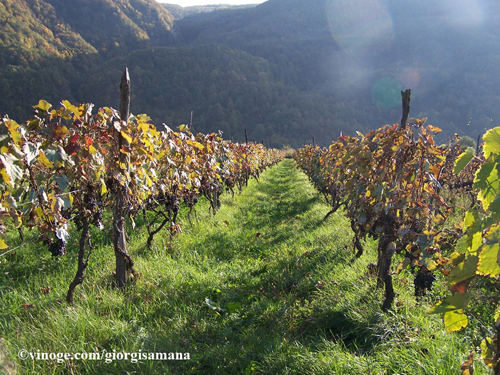
2011
In Kakheti, 2011 was, according to many vine-growers, a strange year. In some regions, however, it was a relatively good year, and 2011 even turned out to be a particularly successful year for the Napareuli and Kindzmarauli areas. Some vine-growers maintain that in terms of climate 2011 was one of the best years: a cold winter was followed by a relatively stable and cool spring, with vines beginning to grow during the first half of May and in some areas grapes being ready to be harvested without any fungal diseases or insect infestations. Despite the fact that the right bank of the Alazani River was also relatively free of pests, the harvest of grapes growing there was late and the sugar content was insufficient—not to mention the ripeness of the stalks, which is the main condition for the production of Kakhetian qvevri wine. In the Kindzmarauli micro-zone in September, the sugar content of the grapes did not exceed 22-23 per cent. Many vine-growers hurried and harvested their vineyards earlier than they should have; the patience of others, however, was rewarded with amazing grapes.
The winter in Kartli was moderately cold and quite bright, but spring and summer were the wettest and coldest of recent years. Here, too, grapes ripened late, and the most active part of the harvest took place during early and mid-October. Because the harvest was relatively late, some wine-makers produced quite strong wines (14%).
Vine-growers in Imereti can be counted among the country’s happiest in 2011; after years of problems, the harvest of 2011 was an excellent one. The winter in Imereti was moderately cold and quite wet and snowy. Early spring was cold and wet, but temperatures rose in April and May and the vines grew well. The summer was dry, and the vineyards were free of disease. A hot August and a more moderate September helped the grapes ripen. The grape harvest in Imereti was at its most active in mid-October.
Thanks to the grapes’ high sugar content, the white wines produced in some villages (e.g. in Sviri, Obcha, etc.) were unusually strong (13.5%). Those vine-growers who delayed the harvest of their Otskhanuri sapere grapes until the first snow were rewarded with a very deep and very red wine.
The winter of 2011 in Racha was relatively warm. Growth began early, and although the summer was quite hot this had no ill effect upon the vineyards. Generally-speaking, 2011 was a relatively successful year for Racha’s wine-makers. The same, however, cannot be said for the neighbouring region of Lechkhumi, where the harvest was damaged.
2011 was quite a difficult year for Guria, Mingrelia and Adjara because of rain, low temperatures and early snow, but local vine-growers were quite pleased with the harvest of Chkhaveri and Ojaleshi grapes. Compared to 2010, Chkhaveri from the harvest of 2011 is distinguished by its high acidity and joyfulness.
2012
2012 turned out to be a very difficult year for Kakheti. A long, wet winter gave way to a hot spring, and vines flowered early. The long and hot summer was interspersed with storms, and on the 19th of July an exceptionally strong hailstorm struck the region—causing damage across the entire region, notably around the towns of Gurjaani and Telavi. The right bank of the Alazani River—which comprises appellations such as Akhasheni, Mukuzani, Vazisubani and Tsinandali—also suffered greatly. The left bank—including the Napareuli, Eniseli, Shilda and Kindzmarauli micro-zones—suffered less even though many villages were damaged by hail. This year, the harvest in Kakheti began unusually early, and those wine-makers whose vineyards were left relatively unscathed are quite pleased. This is largely the case of wines produced from vineyards growing on the left bank of the Alazani River, which according to some people will be full-bodied, rich in sugar and quite strong this year, with a high potential for ageing.
The 2012 harvest in Georgia’s other regions was quite successful. Some risks were taken, but all in all vine-growers are quite satisfied. Kartli had one of its coldest winters of the past few years; spring was moderately wet, and the summer quite hot. Here, too, it was obvious that the grapes would ripen early, and in August they already began to look ripe. In the end, grapes in Kartli were finally ripe enough to be harvested towards the end of September.
In Imereti, a long winter and a cold spring dictated a late start for growth, but the rate of growth picked up quite quickly. The first half of summer was quite cool, but temperatures in August soared to record heights and the harvest in Imereti therefore began one or two weeks early.
In Racha, too, plant growth started early, and by the summer it had become clear that the harvest would begin 10-12 days earlier than usual.
Growth in Guria and in Mingrelia, on the other hand, began late and vines suffered to some extent during the course of the year. A very warm and mild autumn, however, enabled the grapes to ripen very well and the harvest was of a high quality. Compared with previous years, the harvest of 2012 was a rich one.
© Malkhaz Kharbedia/Georgian Wine Guide






